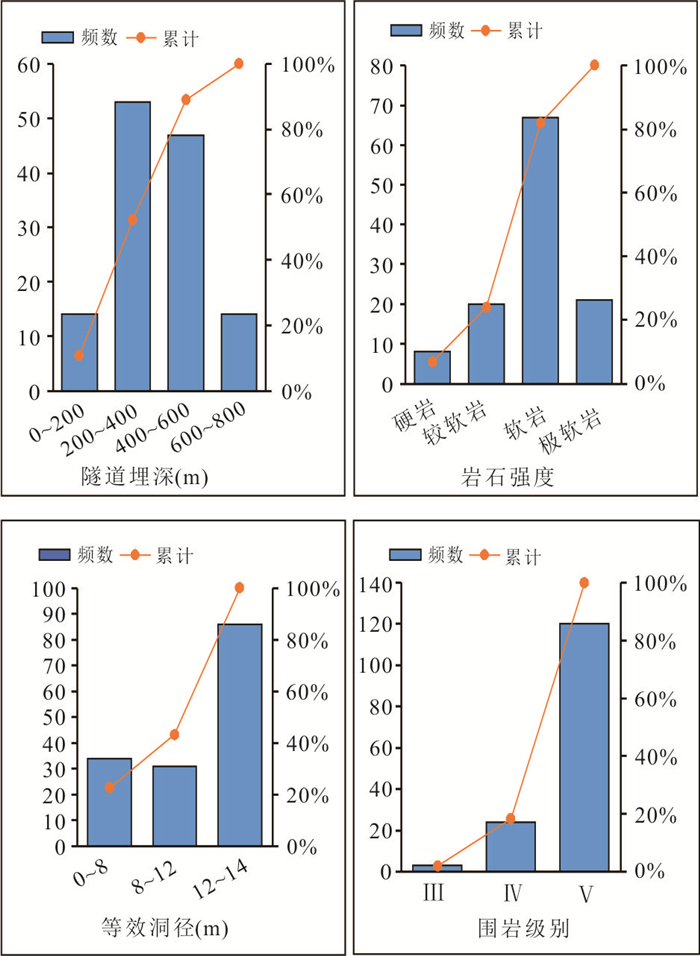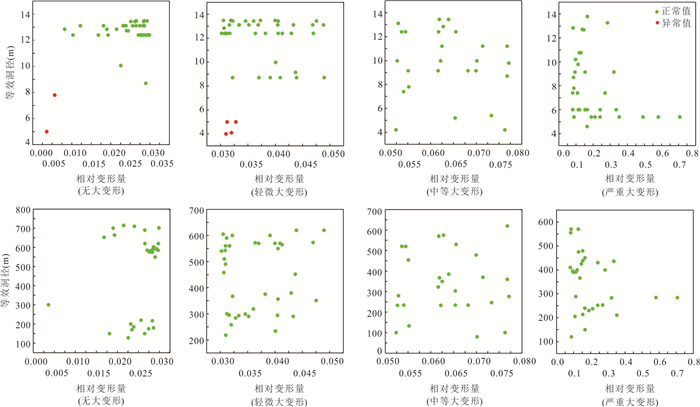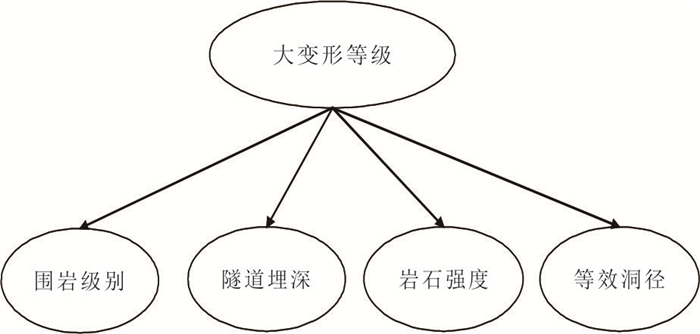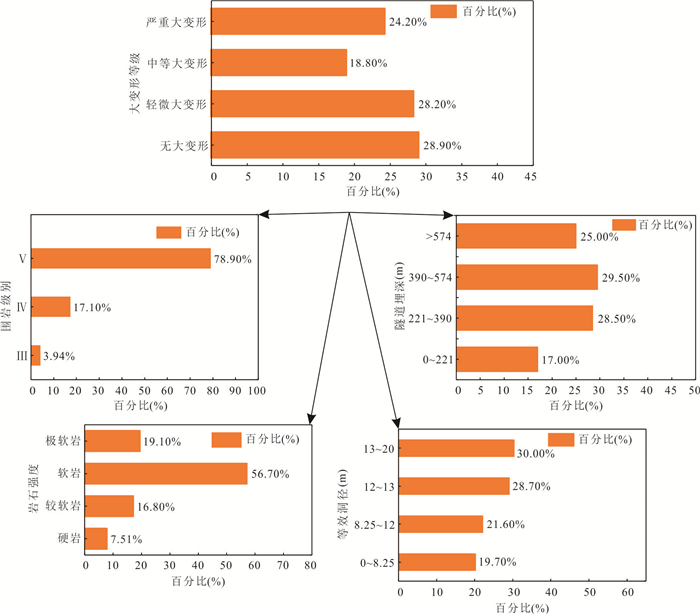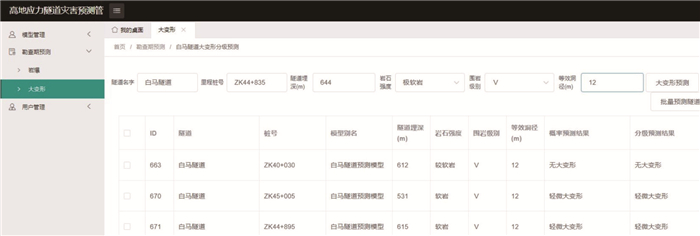Probabilistic Classification Prediction of Tunnel Squeezing Based on Bayesian Network and Its Application during Investigation and Design Stage
-
摘要: 我国西南山区的铁路和公路隧道在遭遇高地应力、软岩和断层破碎带等不良地质条件时常发生挤压大变形灾害,带来巨大的经济损失.从隧道工程勘察设计期的实际需求出发,考虑该阶段预测指标的易获取性,以隧道埋深、围岩级别、等效洞径和岩石强度作为预测指标;搜集建立了以我国西南地区隧道工程为主的包含151组大变形案例的数据库.采用贝叶斯网络模型建立了不完整数据条件下隧道挤压大变形灾害概率分级预测模型,通过十折交叉验证确定模型准确率为76.52%.基于该模型研发了一款大变形分级预测软件平台,并在九绵高速公路白马隧道开展应用,预测准确率达71.11%.本研究成果可为我国西南地区类似地质环境条件下隧道勘察设计期大变形灾害预测提供技术支撑.Abstract: Railway and highway tunnels located in southwest mountainous areas of China often suffer from tunnel squeezing due to high geo-stress, soft rock and fault fracture zone, which bring huge economic losses. To fulfill the requirements of tunnel alignment and design, considering the accessibility of prediction indexes in this stage, the buried depth, surrounding rock grade, equivalent tunnel diameter and rock strength were taken as prediction indexes. Data containing 151 groups of tunnel squeezing cases were collected and a database was established based on tunnels located in Southwest China. The Bayesian network was used to establish the probability classification prediction model of tunnel squeezing with incomplete data. The accuracy of the model was found to be 76.52% by ten-fold cross validation. Based on this model, the tunnel squeezing classification prediction software platform was established. It was applied in Baima tunnel of Jiu-Mian Expressway. The prediction accuracy was 71.11%. The research results of this paper can provide a technical support for the prediction of tunnel squeezing during investigation and design stage under similar geological conditions in Southwest China.
-
表 1 隧道大变形分级标准
Table 1. Classification of tunnel squeezing
大变形等级 相对变形量 围岩变形特征 无大变形 < 3% - 轻微大变形 3%~5% 围岩级别Ⅳ ~ Ⅴ级;开挖后围岩位移较大,持续时间较长;一般支护开裂或破损较严重;围岩自稳时间短,
以塑流型、弯曲型、滑移型变形模式为主,兼有剪切变形.中等大变形 5%~8% 围岩级别Ⅳ ~ Ⅴ级;开挖后围岩位移大,持续时间长;一般支护开裂或破损严重;洞底有隆起现象,
围岩自稳时间很短,以塑流型、弯曲型变形模式为主.严重大变形 > 8% 围岩级别Ⅳ ~ Ⅴ级;开挖后围岩位移很大,持续时间很长;一般支护开裂或破损很严重;
洞底有明显隆起现象,流变特征很明显;围岩自稳时间很短,以塑流型变形模式为主.表 2 预测变量间的相关性系数
Table 2. Correlation coefficient of prediction indexes
隧道埋深 围岩级别 岩石强度 等效洞径 隧道埋深 1 0.237 0.199 0.160 围岩级别 0.237 1 ‒0.026 0.372 岩石强度 0.199 ‒0.026 1 0.017 等效洞径 0.160 0.372 0.017 1 表 3 预测指标离散化与区间节点取值
Table 3. Discretization of prediction index and the corresponding interval node value
指标 描述 区间样本数量 大变形等级 无大变形(0) 42 轻微大变形(1) 41 中等大变形(2) 27 严重大变形(3) 35 围岩级别 Ⅲ级(3) 2 Ⅳ级(4) 22 Ⅴ级(5) 118 岩石强度 硬岩(0) 6 较软岩(1) 17 软岩(2) 66 极软岩(3) 21 隧道埋深(m) 0~221 19 221~390 39 390~574 37 > 574 28 等效洞径(m) 0~8.25 28 8.25~12 31 12~13 42 > 13 44 注:括号内为离散化区间赋值. 表 4 白马隧道大变形预测指标信息与预测结果
Table 4. Prediction indexes and results of tunnel squeezing for Baima tunnel
序号 里程 岩石强度 隧道埋深(m) 围岩级别 等效洞径(m) 预测大变形等级及其发生概率 实际大变形等级 1 ZK40+010 较软岩 599 Ⅴ 12 无大变形(60.9%) 轻微大变形 2 ZK40+020 较软岩 608 Ⅴ 12 无大变形(60.9%) 轻微大变形 3 ZK40+030 较软岩 612 Ⅴ 12 无大变形(60.9%) 轻微大变形 4 ZK40+040 较软岩 622 Ⅴ 12 无大变形(60.9%) 无大变形 5 ZK40+050 较软岩 626 Ⅴ 12 无大变形(60.9%) 无大变形 6 ZK40+060 较软岩 630 Ⅴ 12 无大变形(60.9%) 无大变形 7 ZK40+070 较软岩 636 Ⅴ 12 无大变形(60.9%) 无大变形 8 ZK40+080 较软岩 642 Ⅴ 12 无大变形(60.9%) 无大变形 9 ZK40+090 较软岩 646 Ⅴ 12 无大变形(60.9%) 无大变形 10 ZK40+100 较软岩 655 Ⅴ 12 无大变形(60.9%) 无大变形 11 ZK40+110 较软岩 648 Ⅴ 12 无大变形(60.9%) 无大变形 12 ZK40+120 较软岩 645 Ⅴ 12 无大变形(60.9%) 无大变形 13 YK41+010 极软岩 930 Ⅴ 12 中等大变形(43.6%) 中等大变形 14 YK41+020 极软岩 940 Ⅴ 12 中等大变形(43.6%) 中等大变形 15 YK41+030 极软岩 945 Ⅴ 12 中等大变形(43.6%) 中等大变形 16 YK41+040 极软岩 950 Ⅴ 12 中等大变形(43.6%) 中等大变形 17 YK41+050 极软岩 960 Ⅴ 12 中等大变形(43.6%) 轻微大变形 18 ZK44+755 极软岩 660 Ⅴ 12 中等大变形(43.6%) 无大变形 19 ZK44+765 极软岩 655 Ⅴ 12 中等大变形(43.6%) 中等大变形 20 ZK44+775 极软岩 648 Ⅴ 12 中等大变形(43.6%) 中等大变形 21 ZK44+785 极软岩 646 Ⅴ 12 中等大变形(43.6%) 中等大变形 22 ZK44+795 极软岩 644 Ⅴ 12 中等大变形(43.6%) 中等大变形 23 ZK44+805 极软岩 635 Ⅴ 12 中等大变形(43.6%) 中等大变形 24 ZK44+815 极软岩 640 Ⅴ 12 中等大变形(43.6%) 中等大变形 25 ZK44+825 极软岩 642 Ⅴ 12 中等大变形(43.6%) 强烈大变形 26 ZK44+835 极软岩 644 Ⅴ 12 中等大变形(43.6%) 中等大变形 27 ZK44+845 极软岩 645 Ⅴ 12 中等大变形(43.6%) 中等大变形 28 ZK44+855 极软岩 640 Ⅴ 12 中等大变形(43.6%) 中等大变形 29 ZK44+865 极软岩 634 Ⅴ 12 中等大变形(43.6%) 轻微大变形 30 ZK44+876 软岩 622 Ⅴ 12 轻微大变形(50.3%) 轻微大变形 31 ZK44+895 软岩 615 Ⅴ 12 轻微大变形(50.3%) 轻微大变形 32 ZK44+905 软岩 603 Ⅴ 12 轻微大变形(50.3%) 轻微大变形 33 ZK44+915 软岩 598 Ⅴ 12 轻微大变形(50.3%) 轻微大变形 34 ZK44+925 软岩 588 Ⅴ 12 轻微大变形(50.3%) 轻微大变形 35 ZK44+935 软岩 583 Ⅴ 12 轻微大变形(50.3%) 中等大变形 36 ZK44+945 软岩 575 Ⅴ 12 轻微大变形(50.3%) 中等大变形 37 ZK44+975 软岩 555 Ⅴ 12 轻微大变形(62.2%) 中等大变形 38 ZK44+985 软岩 550 Ⅴ 12 轻微大变形(62.2%) 无大变形 39 ZK44+995 软岩 542 Ⅴ 12 轻微大变形(62.2%) 轻微大变形 40 ZK45+005 软岩 531 Ⅴ 12 轻微大变形(62.2%) 轻微大变形 41 ZK45+015 软岩 518 Ⅴ 12 轻微大变形(62.2%) 轻微大变形 42 YK44+780 极软岩 662 Ⅴ 12 中等大变形(43.6%) 中等大变形 43 YK44+790 极软岩 658 Ⅴ 12 中等大变形(43.6%) 轻微大变形 44 YK44+800 极软岩 656 Ⅴ 12 中等大变形(43.6%) 轻微大变形 45 YK44+810 极软岩 648 Ⅴ 12 中等大变形(43.6%) 中等大变形 注:一个里程桩号代表其前后共10 m的范围. -
Aydan, Ö., Akagi, T., Kawamoto, T., 1993. The Squeezing Potential of Rocks around Tunnels; Theory and Prediction. Rock Mechanics and Rock Engineering, 26(2): 137-163. doi: 10.1007/BF01023620 Bhasin, R., Grimstad, E., 1996. The Use of Stress-Strength Relationships in the Assessment of Tunnel Stability. Tunnelling and Underground Space Technology, 11(1): 93-98. doi: 10.1016/0886-7798(95)00047-X Bhawani, S., Jethwa, J. L., Dube, A. K., et al., 1992. Correlation between Observed Support Pressure and Rock Mass Quality. Tunnelling and Underground Space Technology, 7(1): 59-74. doi: 10.1016/0886-7798(92)90114-W Bonett, D. G., Wright, T. A., 2000. Sample Size Requirements for Estimating Pearson, Kendall and Spearman Correlations. Psychometrika, 65(1): 23-28. doi: 10.1007/BF02294183 China Railway No. 2 Engineer Group Co. Ltd., 2000. General Report and Sub-Item Report on Excavation and Support Technology of Poor Geological Tunnel (in Chinese). China State Bureau of Standards, 1985. Statistical Treatment and Interpretation of Data-Normal Sample Outlier Handling (in Chinese). Chen, S. K., Zhou, H., Liao, X., et al., 2022. Line Selection for Disaster Reduction of High Geostress Tunnel on the Sichuan-Tibet Railway. Earth Science, 47(3): 803-817 (in Chinese with English abstract). Chen, Y., Li, T., Zeng, P., et al., 2020. Dynamic and Probabilistic Multi-Class Prediction of Tunnel Squeezing Intensity. Rock Mechanics and Rock Engineering, 53(8): 3521-3542. doi: 10.1007/s00603-020-02138-8 Cheng, Q. Y., 2010. Structure Entropy Weight Method to Confirm the Weight of Evaluating Index. Systems Engineering-Theory & Practice, 30(7): 1225-1228 (in Chinese with English abstract). http://www.sysengi.com/CN/article/downloadArticleFile.do?attachType=PDF&id=106597 Dempster, A. P., Laird, N. M., Rubin, D. B., 1977. Maximum Likelihood from Incomplete Data via the EM Algorithm. Journal of the Royal Statistical Society Series B: Statistical Methodology, 39(1): 1-22. https://doi.org/10.1111/j.2517-6161.1977.tb01600.x Ding, Y. Z., Tan, Z. S., Ma, D., 2017. Study on Large Deformation Characteristics and Control Measures of Soft Rock Tunnel in Fault Zone with High Geostress. China Civil Engineering Journal, 50(S1): 129-134 (in Chinese with English abstract). http://en.cnki.com.cn/Article_en/CJFDTotal-TMGC2017S1023.htm Dwivedi, R. D., Singh, M., Viladkar, M. N., et al., 2013. Prediction of Tunnel Deformation in Squeezing Grounds. Engineering Geology, 161: 55-64. doi: 10.1016/j.enggeo.2013.04.005 Fan, X. M., Rossiter, D. G., van Westen, C. J., et al., 2014. Empirical Prediction of Coseismic Landslide Dam Formation. Earth Surface Processes and Landforms (The Journal of the British Geomorphological Research Group), 39(14): 1913-1926. doi: 10.1002/esp.3585 Feng, X., Jimenez, R., 2015. Predicting Tunnel Squeezing with Incomplete Data Using Bayesian Networks. Engineering Geology, 195: 214-224. doi: 10.1016/j.enggeo.2015.06.017 Goel, R., Jethwa, J., Paithankar, A., 1995. Indian Experiences with Q and RMR Systems. Tunnelling and Underground Space Technology, 10(1): 97-109. doi: 10.1016/0886-7798(94)00069-W Hall, M., Frank, E., Holmes, G., et al., 2009. The WEKA Data Mining Software: An Update. ACM SIGKDD Explorations Newsletter, 11(1): 10-18. doi: 10.1145/1656274.1656278 He, M. C., Jing, H. H., Sun, X. M., 2002. Soft Rock Engineering Mechanics. Science Press, Beijing (in Chinese). Hoek, E., 2001. Big Tunnels in Bad Rock. Journal of Geotechnical and Geoenvironmental Engineering, 127(9): 73575412. http://www.researchgate.net/publication/228583544_Big_tunnels_in_bad_rock_2000_Terzaghi_Lecture Hoek, E., Marinos, P., 2000. Predicting Tunnel Squeezing Problems in Weak Heterogeneous Rock Masses. Tunnels and Tunnelling International, 32(11): 45-51. Jimenez, R., Recio, D., 2011. A Linear Classifier for Probabilistic Prediction of Squeezing Conditions in Himalayan Tunnels. Engineering Geology, 121(3): 101-109. http://www.xueshufan.com/publication/2062993778 Jiménez, R., Recio, D., 2011. Probabilistic Prediction of Squeezing in Tunneling under High-Stress Conditions. Taylor & Francis Group, London. Korb, K. B., Nicholson, A. E., 2011. Bayesian Artificial Intelligence (2nd Ed. ). CRC Press, Boca Raton. Li, T. B., Meng, L. B., Wang, L. S., 2016. Stability of High Ground Stress Tunnel and Prevention of Rock Burst and Large Deformation Disasters. Science Press, Beijing, 572 (in Chinese). Liu, Z. C., Zhu, Y. Q., Li, W. J., et al., 2008. Mechanism and Classification Criterion for Large Deformation of Squeezing Ground Tunnels. Chinese Journal of Geotechnical Engineering, 30(5): 690-697 (in Chinese with English abstract). http://www.researchgate.net/publication/282736099_Mechanism_and_classification_criterion_for_large_deformation_of_squeezing_ground_tunnels Mahdevari, S., Torabi, S. R., 2012. Prediction of Tunnel Convergence Using Artificial Neural Networks. Tunnelling and Underground Space Technology, 28: 218-228. doi: 10.1016/j.tust.2011.11.002 Pearl, J., 1985. Bayesian Netwcrks: A Model CF Self- Activated Memory for Evidential Reasoning. Proceedings of the 7th Conference of the Cognitive Science Society, University of California, Irvine, 15-17. Ren, Y., Li, T. B., 2011. Application of Large Deformation Forecast Method for Surrounding Rocks Based on Hierarchical Analysis and Extension Theory. Modern Tunnelling Technology, 48(4): 6-12, 18 (in Chinese with English abstract). doi: 10.3969/j.issn.1009-6582.2011.04.002 Saari, K., 1982. Analysis of Plastic Deformation (Squeezing) of Layers Intersecting Tunnels and Shafts in Rock (Dissertation). University of California, Berkeley. Singh, B., Goel, R. K., 1999. Rock Mass Classification: A Practical Approach in Civil Engineering. Elsevier, Amsterdam. Singh, D. P., Wood, D. A., Singh, V., et al., 2022. Impact of Particle Crush-Size and Weight on Rock-Eval S2, S4, and Kinetics of Shales. Journal of Earth Science, 33(2): 513-524. doi: 10.1007/s12583-021-1452-9 Sun, Y., Feng, X. D., Yang, L. Q., 2018. Predicting Tunnel Squeezing Using Multiclass Support Vector Machines. Advances in Civil Engineering, 2018: 4543984. http://en.cnki.com.cn/Article_en/CJFDTotal-JZSX201808085.htm Wang, X. R., Cai, S., Yang, W., et al., 2022. Influence of Existing Buildings on Construction of Earth Pressure Shield in Extremely Soft Rock Stratum. Earth Science, 47(4): 1483-1491 (in Chinese with English abstract). Xiong, Y. Y., Wu, X. Q., 2010. The Generalizing Application of Four Judging Criterions for Gross Errors. Physical Experiment of College, 23(1): 66-68 (in Chinese with English abstract). http://en.cnki.com.cn/Article_en/CJFDTOTAL-DWSL201001023.htm Xu, L. S., Li, Y. L., Cheng, C. G., 2002. Judging of the Deformation-Cracking Type and Grade about Surrounding Rock of Highway Tunnel. Journal of Chongqing Jiaotong University, 21(2): 16-20 (in Chinese with English abstract). http://www.cqvip.com/Main/Detail.aspx?id=6323928 Zhang, G. Z., Deng, J. H., Wang, D., et al., 2021. Mechanism and Classification of Tectonic-Induced Large Deformation of Soft Rock Tunnels. Advanced Engineering Sciences, 53(1): 1-12 (in Chinese with English abstract). Zhang, Z. D., 2003. Discussion and Study on Large Deformation of Tunnel in Squeezing Ground. Modern Tunnelling Technology, 40(2): 5-12, 40 (in Chinese with English abstract). http://en.cnki.com.cn/Article_en/CJFDTOTAL-XDSD200302001.htm Zhao, Y., 2012. Study on Deformation Mechanism and Control Technology of Weak Rock Surrounding Tunnel (Dissertation). Beijing Jiaotong University, Beijing (in Chinese with English abstract). 中铁二局集团有限公司, 2000. 不良地质隧道的开挖及支护技术研究总报告及分项报告. 中国国家标准局, 1985. 数据的统计处理和解释-正态样本异常值处理. 陈仕阔, 周航, 廖昕, 等, 2022. 川藏铁路高地应力隧道减灾选线. 地球科学, 47(3): 803-817. 程启月, 2010. 评测指标权重确定的结构熵权法. 系统工程理论与实践, 30(7): 1225-1228. https://www.cnki.com.cn/Article/CJFDTOTAL-XTLL201007012.htm 丁远振, 谭忠盛, 马栋, 2017. 高地应力断层带软岩隧道变形特征与控制措施研究. 土木工程学报, 50(S1): 129-134. https://www.cnki.com.cn/Article/CJFDTOTAL-TMGC2017S1023.htm 何满潮, 景海河, 孙晓明, 2002. 软岩工程力学. 北京: 科学出版社. 李天斌, 孟陆波, 王兰生, 2016. 高地应力隧道稳定性及岩爆、大变形灾害防治. 北京: 科学出版社, 572. 刘志春, 朱永全, 李文江, 等, 2008. 挤压性围岩隧道大变形机理及分级标准研究. 岩土工程学报, 30(5): 690-697. https://www.cnki.com.cn/Article/CJFDTOTAL-YTGC200805014.htm 任洋, 李天斌, 2011. 基于层次分析的可拓学理论围岩大变形预测方法及应用. 现代隧道技术, 48(4): 6-12, 18. https://www.cnki.com.cn/Article/CJFDTOTAL-XDSD201104003.htm 王晓睿, 蔡松, 杨伟, 等, 2022. 既有建筑对极软岩地层中土压盾构的施工影响. 地球科学, 47(4): 1483-1491. doi: 10.3799/dqkx.2020.326 熊艳艳, 吴先球, 2010. 粗大误差四种判别准则的比较和应用. 大学物理实验, 23(1): 66-68. https://www.cnki.com.cn/Article/CJFDTOTAL-DWSL201705028.htm 徐林生, 李永林, 程崇国, 2002. 公路隧道围岩变形破裂类型与等级的判定. 重庆交通学院学报, 21(2): 16-20. https://www.cnki.com.cn/Article/CJFDTOTAL-CQJT200202004.htm 张广泽, 邓建辉, 王栋, 等, 2021. 隧道围岩构造软岩大变形发生机理及分级方法. 工程科学与技术, 53(1): 1-12. https://www.cnki.com.cn/Article/CJFDTOTAL-SCLH202101001.htm 张祉道, 2003. 关于挤压性围岩隧道大变形的探讨和研究. 现代隧道技术, 40(2): 5-12, 40. https://www.cnki.com.cn/Article/CJFDTOTAL-XDSD200302001.htm 赵勇, 2012. 隧道软弱围岩变形机制与控制技术研究(博士学位论文). 北京: 北京交通大学. -









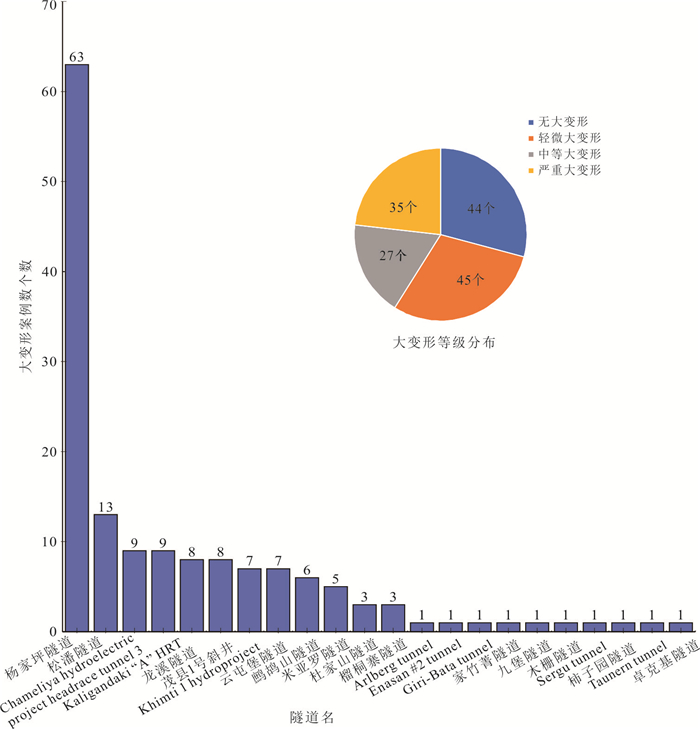
 下载:
下载:
